|
|
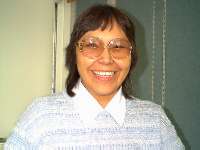 |
Even
though she tried really hard, Darlene Rae couldn't hide behind
the camera for the entire conference. Thanks Darlene for taking
all of the terrific pictures. |
 |
Early
dawn in Red Lake as last minute arrangements are being made
for the conference. |
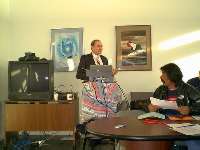 |
Brian
Beaton welcomed everyone, reviewed the agenda (which had to
be flexible (yet strict) to accommodate some of the new events
and still address the scheduled video conference sessions. |
Brian presented an OVERVIEW
document outlining the various work accomplished over the past five
years of development. The challenge to everyone present is to ensure
the work continues with a common agenda (one of the reasons for
this conference).
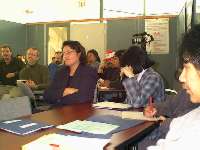 |
Conference
participants included community representatives from each Keewaytinook
Okimakanak First Nation, special resource people, Keewaytinook
Okimakanak program staff members from both the Red Lake and
Sioux Lookout offices. Where did all the equipment go?? |
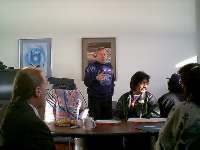 |
We
were fortunate to have Howard Hampton, MPP for our riding, so
he can continue to lobby and support our efforts as we develop
Keewaytinook Okimakanak telecommunication strategies. |
At this point in the
agenda, the group split into two sections, one went to the local
hospital in Red Lake for a demonstration of the telehealth equipment
and the rest of the group stayed to learn about the program announcement
by FedNor.
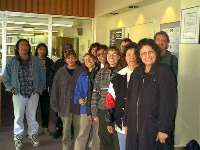 |
Arriving
for the special telehealth demonstration at the local hospital
in Red Lake. The presention involved using a satellite link
from the hospital to the Ottawa Heart Institute (OHI). Alison
Pettunuzzo, the Assistant CEO of the Margaret Couchenour Hospital,
facilitated the session. Roy Marsh and Sharon-Anne Kearns -
an RN working with the project - talked about their pilot project
and the ways that patients and health professionals felt about
using this new consultation tool. Thanks to Roy Marsh for bringing
the session to life by opening up his shirt for a "live" digital
stethoscopy demonstration. |
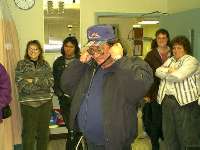 |
We
all lined up to listen to Roy's steady heartbeat. Here's Cornelius
Matthews taking his turn. |
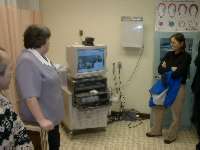 |
People
were very interested in seeing how the telehealth unit work
- there were many questions! Red Lake is the closest hospital
to most Keewaytinook Okimakanak communities and many people
were curious how this same approach might be used for First
Nations healthcare delivery. Roy said that they are writing
an evaluation of the pilot HEART program that connected hospitals
in Red Lake, Pembroke, Almont, Chapleau and Sudbury. We learned
that one of the big barriers to this kind of project is that
OHIP won't pay physicians for tele-consults. |
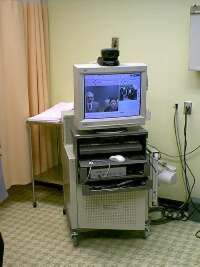 |
The
HEART project began in August 1998, under their Telecommunications
Access Project. This installation was a first step to bringing
these types of services closer to the Keewaytinook Okimakanak
First Nations and was a result (in part) of a visit to OHI by
the Chiefs of Keewaytinook Okimakanak in May 1998. |
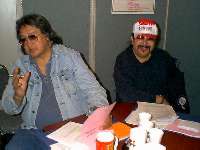 |
Other
people chose to attend an audioconference session with FedNor's
Telecommunications Program Officer, Carl Seibel. Carl talked
about Industry's Canada's recent announcement to support telecommunications
(see http://strategis.ic.gc.ca/SSG/fn00361e.html
). Les Meekis, the Keewaytinook Okimakanak Outreach Officer
and Raymond Mason, Keewaywin Councillor are interested in finding
the resources to get these telecom services into Keewaywin First
Nation. |
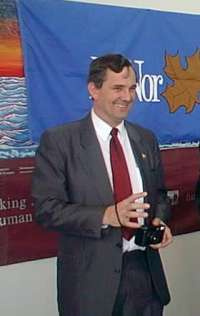 |
One
step discussed during this session was to build a SMART demonstration
facility at the new Keewaytinook Okimakanak administration building
in Balmertown. This picture of Carl was taken during the Honourable
John Manley's trip to Red Lake in May of this year. |
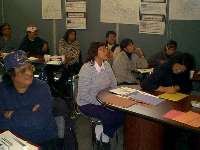 |
We
all got back together just before lunch. Don Richardson and
Ricardo Ramirez of the Telecommons Development Group (TDG) talked
about the PLANNING PROCESS
during the next few days and asked people to think about how
we could harness communication and information technologies
for our communities. |
 |
An
excellent lunch is served to the participants by the local caterers
(First Nation entrepreneurs). |
|













